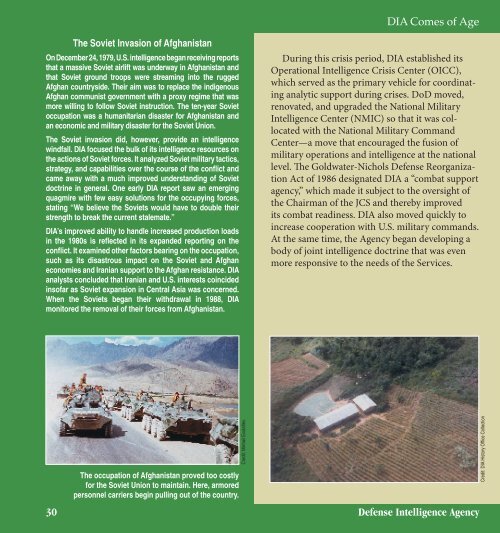A History of the Defense Intelligence Agency - Cryptocomb
A History of the Defense Intelligence Agency - Cryptocomb
A History of the Defense Intelligence Agency - Cryptocomb
Create successful ePaper yourself
Turn your PDF publications into a flip-book with our unique Google optimized e-Paper software.
1980s<br />
The Soviet Invasion <strong>of</strong> Afghanistan<br />
On December 24, 1979, U.S. intelligence began receiving reports<br />
that a massive Soviet airlift was underway in Afghanistan and<br />
that Soviet ground troops were streaming into <strong>the</strong> rugged<br />
Afghan countryside. Their aim was to replace <strong>the</strong> indigenous<br />
Afghan communist government with a proxy regime that was<br />
more willing to follow Soviet instruction. The ten-year Soviet<br />
occupation was a humanitarian disaster for Afghanistan and<br />
an economic and military disaster for <strong>the</strong> Soviet Union.<br />
The Soviet invasion did, however, provide an intelligence<br />
windfall. DIA focused <strong>the</strong> bulk <strong>of</strong> its intelligence resources on<br />
<strong>the</strong> actions <strong>of</strong> Soviet forces. It analyzed Soviet military tactics,<br />
strategy, and capabilities over <strong>the</strong> course <strong>of</strong> <strong>the</strong> conflict and<br />
came away with a much improved understanding <strong>of</strong> Soviet<br />
doctrine in general. One early DIA report saw an emerging<br />
quagmire with few easy solutions for <strong>the</strong> occupying forces,<br />
stating “We believe <strong>the</strong> Soviets would have to double <strong>the</strong>ir<br />
strength to break <strong>the</strong> current stalemate.”<br />
DIA’s improved ability to handle increased production loads<br />
in <strong>the</strong> 1980s is reflected in its expanded reporting on <strong>the</strong><br />
conflict. It examined o<strong>the</strong>r factors bearing on <strong>the</strong> occupation,<br />
such as its disastrous impact on <strong>the</strong> Soviet and Afghan<br />
economies and Iranian support to <strong>the</strong> Afghan resistance. DIA<br />
analysts concluded that Iranian and U.S. interests coincided<br />
ins<strong>of</strong>ar as Soviet expansion in Central Asia was concerned.<br />
When <strong>the</strong> Soviets began <strong>the</strong>ir withdrawal in 1988, DIA<br />
monitored <strong>the</strong> removal <strong>of</strong> <strong>the</strong>ir forces from Afghanistan.<br />
DIA Comes <strong>of</strong> Age<br />
During this crisis period, DIA established its<br />
Operational <strong>Intelligence</strong> Crisis Center (OICC),<br />
which served as <strong>the</strong> primary vehicle for coordinating<br />
analytic support during crises. DoD moved,<br />
renovated, and upgraded <strong>the</strong> National Military<br />
<strong>Intelligence</strong> Center (NMIC) so that it was collocated<br />
with <strong>the</strong> National Military Command<br />
Center—a move that encouraged <strong>the</strong> fusion <strong>of</strong><br />
military operations and intelligence at <strong>the</strong> national<br />
level. The Goldwater-Nichols <strong>Defense</strong> Reorganization<br />
Act <strong>of</strong> 1986 designated DIA a “combat support<br />
agency,” which made it subject to <strong>the</strong> oversight <strong>of</strong><br />
<strong>the</strong> Chairman <strong>of</strong> <strong>the</strong> JCS and <strong>the</strong>reby improved<br />
its combat readiness. DIA also moved quickly to<br />
increase cooperation with U.S. military commands.<br />
At <strong>the</strong> same time, <strong>the</strong> <strong>Agency</strong> began developing a<br />
body <strong>of</strong> joint intelligence doctrine that was even<br />
more responsive to <strong>the</strong> needs <strong>of</strong> <strong>the</strong> Services.<br />
The occupation <strong>of</strong> Afghanistan proved too costly<br />
for <strong>the</strong> Soviet Union to maintain. Here, armored<br />
personnel carriers begin pulling out <strong>of</strong> <strong>the</strong> country.<br />
Credit: Mikhail Evstafiev.<br />
30 <strong>Defense</strong> <strong>Intelligence</strong> <strong>Agency</strong><br />
Credit: DIA <strong>History</strong> Office Collection

















